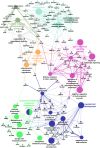Role of innate immunity-triggered pathways in the pathogenesis of Sickle Cell Disease: a meta-analysis of gene expression studies
- PMID: 26648000
- PMCID: PMC4673434
- DOI: 10.1038/srep17822
Role of innate immunity-triggered pathways in the pathogenesis of Sickle Cell Disease: a meta-analysis of gene expression studies
Abstract
Despite the detailed characterization of the inflammatory and endothelial changes observed in Sickle Cell Disease (SCD), the hierarchical relationship between elements involved in the pathogenesis of this complex disease is yet to be described. Meta-analyses of gene expression studies from public repositories represent a novel strategy, capable to identify key mediators in complex diseases. We performed several meta-analyses of gene expression studies involving SCD, including studies with patient samples, as well as in-vitro models of the disease. Meta-analyses were performed with the Inmex bioinformatics tool, based on the RankProd package, using raw gene expression data. Functional gene set analysis was performed using more than 60 gene-set libraries. Our results demonstrate that the well-characterized association between innate immunity, hemostasis, angiogenesis and heme metabolism with SCD is also consistently observed at the transcriptomic level, across independent studies. The enrichment of genes and pathways associated with innate immunity and damage repair-associated pathways supports the model of erythroid danger-associated molecular patterns (DAMPs) as key mediators of the pathogenesis of SCD. Our study also generated a novel database of candidate genes, pathways and transcription factors not previously associated with the pathogenesis of SCD that warrant further investigation in models and patients of SCD.
Figures


References
-
- Rees D. C., Williams T. N. & Gladwin M. T. Sickle-cell disease. Lancet 376, 2018–31 (2010). - PubMed
-
- Vilas-Boas W. Sickle cell disease: Only one road, but different pathways for inflammation. Adv. Biosci. Biotechnol. 03, 538–550 (2012).
Publication types
MeSH terms
LinkOut - more resources
Full Text Sources
Other Literature Sources
Medical

